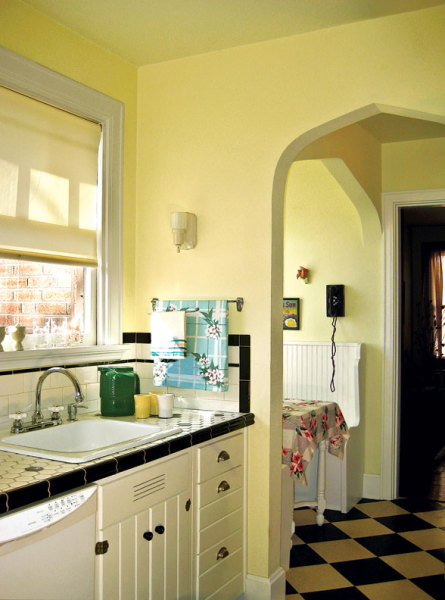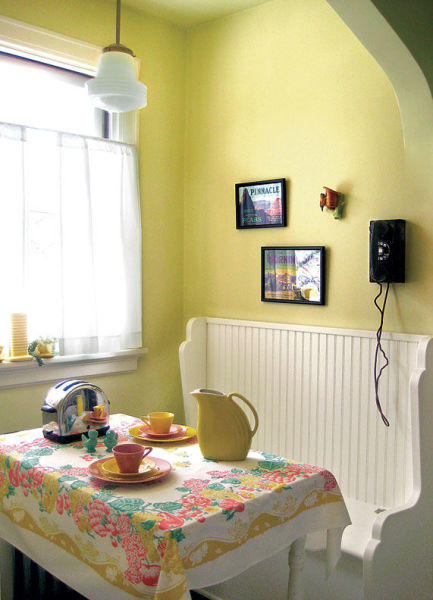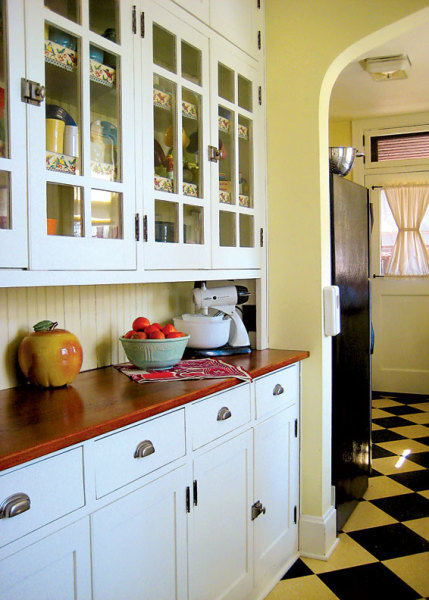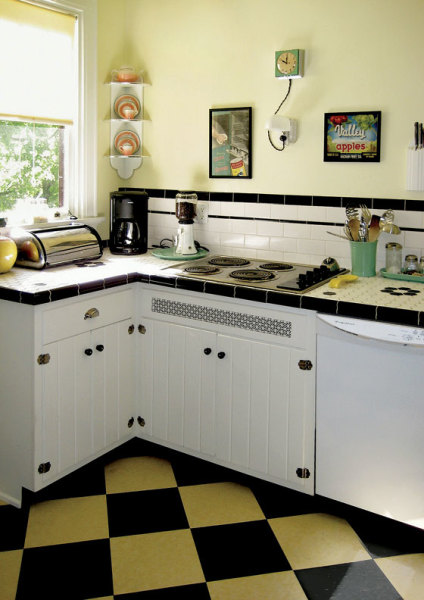The shallow single-bowl sink and faucet with porcelain cross handles were must-haves for the couple’s retro kitchen.
Photos by Ken Lay
The house was like a dream: A 1932 Tudor in Cincinnati’s Westwood neighborhood, under the care of the same owners for nearly half a century, and immaculately preserved, with the original woodwork, bathroom fixtures, and Batchelder fireplace still intact. Ken Lay and Mary Bryan, avid Arts & Crafts collectors, knew instantly that it was “the one.”
There was just one problem: the kitchen. Remodeled in the late 1950s when the previous owners took up residence, it was a clunky mélange of poorly placed cabinets, sparkly pink worn Formica countertops, and dingy brown linoleum. “It was a 1950s kitchen, but it wasn’t a cool 1950s kitchen—it was the kind people roll their eyes at,” says Mary. “‘Depressing’ would be the best word to describe it.”
The couple knew they wanted a retro-style kitchen that would both fit the time period of the house and appeal to their finely honed aesthetic sensibilities (Ken is a graphic designer by trade; Mary has a degree in interior design), but they were also aware of falling property values in the area, and didn’t want to sink too much money into a kitchen overhaul. The solution? Buy as much as possible off the shelf, and perform all of the work themselves. The strategy paid off, netting them a refreshed retro kitchen for a price tag of under $3,000.
Bench Bonanza
A restored period toaster and telephone lend authenticity to the breakfast nook.
Ken and Mary started the rehabilitation by creating what has quickly become one of their favorite spaces—the sunny breakfast nook. The previous owners had left behind an early 20th-century Sellers table, so Ken went about designing a pair of benches to match it. “I did a lot of research on what would have been there at the time,” he says. “I wanted something with kind of an Art Deco/machine age feel.”
To soften the Deco-inspired lines and blend the benches with the house’s pedigree, he selected beadboard backing. He also added hinged lids to up the room’s storage ante. He called upon a former colleague, a hobbyist woodworker who was out of a job, to help him select materials and build the benches. “I designed them, he built them, and Mary filled them,” Ken jokes.
In addition to providing a repository for the couple’s collection of vintage tablecloths, the nook has become Mary’s de facto office for the one day a week she works at home. “I’m in the breakfast nook for nine or 10 hours straight,” she says. “I never get tired of being there.”
Retro Redo
With the nook in place, Ken and Mary turned their attention to the remainder of the kitchen—namely, the cabinets, countertops, and floor, which were the room’s most offensive elements. An upper bank of cabinets was obscuring the light from one of the room’s original double-hung windows, so the couple decided to remove it. Doing so drastically cut down on the kitchen’s storage space, but, says Mary, it ended up being a blessing in disguise, as it’s forced them to be more thoughtful in their collecting. “Now every time we pick something up at a flea market or antique store, we really have to think about it,” she says. “There’s nothing in the kitchen we don’t use—even the vintage stuff.”
Ken did help alleviate the loss of storage by installing wire shelving in the utility hall that runs from the kitchen to the basement entrance, turning it into a modern-day butler’s pantry. “Having everything visible, I can do my grocery list in a minute,” Mary says. “I won’t ever go back to upper cabinets—I love the open feeling.”
The butler’s pantry, outfitted with original hardware, a new wood countertop, and retro Royledge shelf edging, houses vintage dishware and kitchen accessories, like a 1950s-era Sunbeam mixer.
The actual butler’s pantry (original to the house), which the couple uses to store their vast collection of vintage tableware, simply needed its Formica countertops and faux-colonial hardware replaced. On a tip from the previous owners’ daughter, the Lays discovered the pantry’s original nickel catches and bin pulls sitting in a coffee can in the corner of the garage. “We even found jars of original screws,” Ken says. “In some cases, I was able to use the original screw holes.” The kitchen’s lower cabinets, installed in the 1950s remodel, were kept intact, but Ken removed the doors and painted them, then outfitted them with Art Deco-style chrome reproduction hardware.
For the countertops, Ken called upon his tiling expertise (he had previously retiled the kitchen and bath in an 1880s town house). The couple borrowed an idea from Jane Powell’s Bungalow Kitchens (“It was our bible,” says Ken) and used sheets of black and white 2″ hex tile laid with ¼” grout joints. (They ignored Powell’s recommendation to remove the tiles from their backing and reduce the pre-sized joints to 1⁄8″, which Mary says they regret: “The grout lines are pretty wide and can get messy.”) They complemented the daisy-pattern countertop with white subway tile, black border edging, and a matchstick tile detail on the backsplash.
When it came time to tackle the floor, however, the harmonious restoration process experienced a major bump. Mary, referencing original blueprints of the house (which they’d found tucked away in the butler’s pantry), was adamant about restoring the yellow pine flooring that had graced the room when the house was built. Ken, on the other hand, loved the 1920s “sanitary” look of black-and-white checkerboard linoleum. The stalemate was beginning to threaten their marriage when they came upon a compromise via an unlikely source.
Vintage advertisements and fruit crate labels, a 1920s sconce, and a Homer Laughlin Santa Fe tea set liven up the wall that once held a clumsy bank of cabinets.
“We were watching You’ve Got Mail,” remembers Ken, “and Meg Ryan’s kitchen in the movie has a really nice butter and teal checkerboard linoleum pattern.” Mary conceded that she could live with the checkerboard floor as long as they steered clear of the “cliché black and white, so they updated the color scheme to black and cream, laying the tiles on the diagonal. “The floor was the only thing we argued about,” she says, “and we both ended up loving the compromise even more than we loved our original ideas.”
Savvy Shopping
Throughout the kitchen, the couple’s eye for design and nose for a bargain combined to keep both period style and budget on track. Their biggest splurge was the built-in benches; smaller details like the pendant light shade above the breakfast nook and period Porcelier sconce near the sink were flea-market or eBay finds.
“We like to spend our time obsessively searching for things that are going to be right in the house,” Mary says. “If you want to save a lot of time, you can’t do a renovation like this.” Ken says calling upon his restoration experience and being willing to get his hands dirty were key to restoring the kitchen cheaply. “The real money is in hiring people to do things,” he observes. “If you can shop with an eye for simplicity and do things yourself, you won’t spend a lot of money.”







